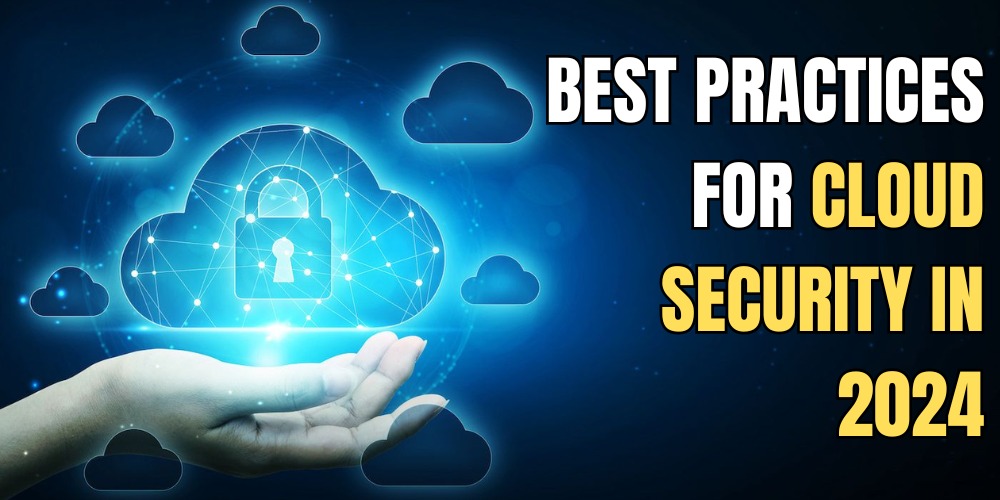-
+91 96679 49121
Best practices for cloud security in 2024

Best practices for cloud security in 2024
As cloud computing continues to grow in prominence, maintaining strong cloud security is foremost for your business. Cyber threats play a major role in degrading your financial or functional policies, placing them at risk. Fusing with cloud security practices can effectively deplete these risks and ensure that your sensitive data remains secure. Here are some best practices for cloud security:
1. Zero Trust Architecture
• Principle of least advantage: Only allow access to data and resources that are entirely necessary for users, applications, or systems. • Verify every request: Authenticate and authorize users, devices, and applications regardless of their location or network. • Continuous monitoring: Constantly monitor user behavior, network traffic, and access patterns for unusual activity.
2. Data Encryption
• Encrypt data at rest and in transit: Use vigorous encryption operations like AES-256 for data at rest and TLS for data in transit to safeguard sensitive data.
• Key management: Execute substantial key management practices, such as using hardware security modules (HSMs), to reserve and handle encryption keys.
3. Identity and Access Management (IAM)
• Multi-factor authentication (MFA): Need MFA for all users, primarily those with access to unfavourable resources.
• Role-based access control (RBAC): Use RBAC to allow consent based on user roles and limit access to only necessary resources.
• Automated user lifecycle management: Incorporate automated systems for handling user access from onboarding to offboarding to ensure access is abandoned when no longer needed.
4. Regular Security Audits and Compliance Checks
• Conduct regular audits: Constantly examine your cloud environments for vulnerabilities, misconfigurations, and conformity with security metrics such as SOC 2, GDPR, and HIPAA.
• Automate conformity monitoring: Use automated tools to ensure consistent conformity with security frameworks and standards.
5. Cloud Configuration Management
• Automated security checks: Use cloud-native security tools to execute automated checks and prevent misconfigurations of cloud infrastructure (e.g., AWS Config, Azure Security Center).
• Least advantage on cloud resources: Safeguard your cloud environments by sticking to the principle of least advantage for services, APIs, and cloud storage.
6. Network Security and Firewalls
• Segment networks: Insulate sensitive data and services in distinct network zones to reduce the impact of potential breaches.
• Use cloud-native firewalls: Imply cloud-specific firewall services and Virtual Private Cloud (VPC) security groups to direct network traffic.
• Implement DDoS protection: Use cloud-native Distributed Denial-of-Service (DDoS) protection services to obstruct harmful traffic.
7. Security Automation and Orchestration
• Automate threat recognition and response: Implement Security Information and Event Management (SIEM) systems and Security Orchestration Automation and Response (SOAR) platforms to recognize, examine, and counter threats concurrently.
• Automate patch management: Assure that all cloud systems are frequently patched and updated to forbid exploitation of known vulnerabilities.
8. Backup and Disaster Recovery Plans
• Regular backups: Carry out automated, frequent backups of explicative data and operations to ensure they can be retrieved in case of a data contravention or security disturbance.
• Disaster recovery (DR): Have a validated DR plan, frequently tested, to ensure slightest downtime and quick recovery in case of a security contravention or failure.
9. Threat Intelligence and Monitoring
• Integrate threat intelligence: Imply threat intelligence feeds to stay updated on upcoming security threats and install them into your monitoring and response strategies.
• Real-time observation: Consistently examine logs, network traffic, and system activity to recognise anomalies or potential threats early.
10. Security Awareness Training
• Employee training: Give proper cloud security education to employees to increase consciousness about potential threats such as phishing, social engineering, and insecure cloud arrangements.
• Replicate phishing attacks: Frequently conduct phishing replications to train employees on how to recognize and respond to phishing attempts.
11. Vendor Risk Management
• Third-party risk evaluation: Conduct extensive risk analysis of third-party cloud providers to ensure they conform to cloud security best practices and directives.
• SLAs and contracts: Make sure that service-level agreements (SLAs) with cloud vendors distinctly determine security responsibilities, including data protection, conformity, and incident response.
12. Cloud Security Posture Management (CSPM)
• Consistent security observation: Use CSPM tools to recognise and amend mis-arrangements and vulnerabilities instantaneously across your cloud infrastructure.
• Security baselines: Establish and implement security measures for your cloud environments to ensure consistent security posture across all cloud resources.
By incorporating these best practices, you can functionally reduce the risk of emerging cyber threats and sustain the benefits of secure cloud computing in 2024.
We, at Makelink Innovation, offer compelling cloud security solutions customized to your needs. Do contact us for such services via mail at [email protected] or visit our website https://makelink.com/contact-us

